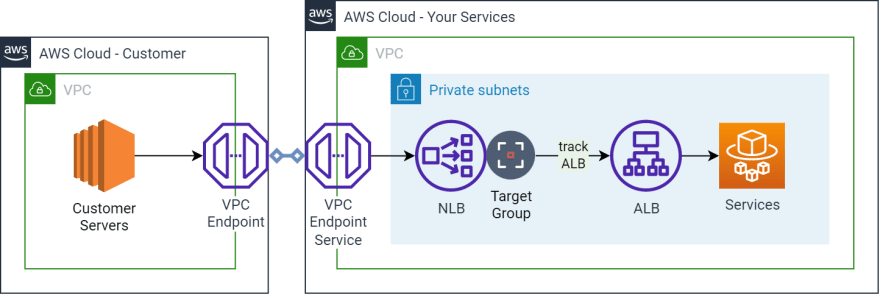VPC ENDPOINTS AND AWS PRIVATELINK
A VPC endpoint allows you to connect your VPC to AWS services and VPC endpoint services privately. Resources within a VPC do not require public IP addresses to communicate with resources outside the VPC when using VPC endpoints. Traffic between an Amazon Virtual Private Cloud (Amazon VPC) and a service is not routed outside of the Amazon network.
VPC endpoints are first and foremost a security product, then a connectivity product. VPC endpoints prevent traffic between your VPC and other services from leaving the Amazon network.
You may have stringent compliance requirements that prevent connectivity between a VPC and a service endpoint that is accessible to the public. VPC endpoints, in this case, provide a way to access AWS services from your VPCs that would otherwise be unavailable.
An internet gateway, virtual private gateway, network address translation (NAT) device, virtual private network (VPN) connection, or Direct Connect connection are not required for a VPC endpoint. To connect to services presented through a VPC endpoint, instances in your VPC do not need a public IP address.
The following are the different types of VPC endpoints.
Gateway vpc endpoints
A gateway VPC endpoint uses a prefix list to target specific IP routes in a VPC route table. This is used for Amazon DynamoDB or Amazon Simple Storage Service (S3) traffic.
To communicate with VPC endpoints, instances in a VPC do not need public IP addresses. This is because interface endpoints within the consumer VPC use local IP addresses. Gateway endpoints are destinations accessible from within a VPC via prefix-lists in the VPC's route table.
Interface endpoints
An interface endpoint, powered by AWS PrivateLink, is an elastic network interface with a private IP address from your subnet's IP address range. It acts as a gateway for traffic headed to a supported AWS service or a VPC endpoint service.
Gateway loadbalancer endpoint
A Gateway Load Balancer endpoint is an elastic network interface with a private IP address from your subnet's IP address range. This type of endpoint acts as an entry point for traffic to be intercepted and routed to a service that you've configured using Gateway Load Balancers.
AWS PrivateLink establishes a secure connection between your VPCs and AWS services. This AWS service ensures secure usage within the AWS network while avoiding traffic exposure to the public internet.
Prior to AWS PrivateLink, services within a single VPC were linked to other VPCs in two ways:
1) Public IP addresses using the internet gateway of the VPC
2) Private IP addresses using VPC peering
With AWS PrivateLink, services establish a Transmission Control Protocol (TCP) connection between the service provider’s VPC and the service consumer’s VPC. This provides a secure and scalable solution.
Following example shows how to create VPC Endpoint Service using Gateway Load Balancer ARN using AWS CloudFormation. It also creates custom resource to output the service name.
AWSTemplateFormatVersion: "2010-09-09"
Description: This template creates Amazon VPC Endpoint Service.
Metadata:
AWS::CloudFormation::Interface:
ParameterGroups:
- Label:
default: Endpoint Service Configuration
Parameters:
- ElbArn
- ConnectionAcceptance
- Label:
default: Endpoint Service Permissions
Parameters:
- AwsAccountToWhitelist
ParameterLabels:
ElbArn:
default: >-
ELB Amazon Resource Names (ARNs)for your service.
ConnectionAcceptance:
default: >-
Indicate whether requests from service consumers to create an
endpoint to your service must be accepted.
AwsAccountToWhitelist:
default: >-
The Amazon Resource Names (ARN) of one or more principals (IAM users,
IAM roles, and AWS accounts). Permissions are granted to the
principals in this list.
Parameters:
ElbArn:
Description: >-
Enter Elastic load balancer ARN for your service. Network and Gateway
Load Balancer are the two supported types.
Type: String
ConstraintDescription: Must be a valid ELB ARN
ConnectionAcceptance:
Description: >-
Acceptance required for endpoint connection or not. Select true or
false to either acceptance required or acceptance not required
default is set to false: acceptance not required
Default: "false"
AllowedValues: ["true", "false"]
Type: String
ConstraintDescription: Must be true or false
AwsAccountToWhitelist:
Description: >-
Enter ARN of one or more prinicapls: IAM user, IAM roles and AWS accounts.
To grant permissions to all principals, specify an asterisk (*).
Type: String
ConstraintDescription: Must be a valid AWS ARN of one or more principals
Resources:
VpcEndpointService:
Type: AWS::EC2::VPCEndpointService
Properties:
GatewayLoadBalancerArns:
- !Ref ElbArn
AcceptanceRequired: !Ref ConnectionAcceptance
VpcEndpointServicePermissions:
Type: AWS::EC2::VPCEndpointServicePermissions
Properties:
AllowedPrincipals:
- !Ref AwsAccountToWhitelist
ServiceId: !Ref VpcEndpointService
LambdaExecutionRole:
Type: AWS::IAM::Role
Properties:
AssumeRolePolicyDocument:
Version: 2012-10-17
Statement:
- Effect: Allow
Principal:
Service:
- lambda.amazonaws.com
Action:
- sts:AssumeRole
Path: /
Policies:
- PolicyName: root
PolicyDocument:
Version: 2012-10-17
Statement:
- Effect: Allow
Action:
- logs:CreateLogGroup
- logs:CreateLogStream
- logs:PutLogEvents
Resource: arn:aws:logs:*:*:*
- Effect: Allow
Action:
- ec2:DescribeVpcEndpointServiceConfigurations
- ec2:DescribeVpcEndpointServicePermissions
- ec2:DescribeVpcEndpointServices
Resource: "*"
DescribeVpceService:
Type: AWS::Lambda::Function
Properties:
Handler: "index.handler"
Role: !GetAtt
- LambdaExecutionRole
- Arn
Code:
ZipFile: |
import boto3
import cfnresponse
import json
import logging
def handler(event, context):
logger = logging.getLogger()
logger.setLevel(logging.INFO)
responseData = {}
responseStatus = cfnresponse.FAILED
logger.info('Received event: {}'.format(json.dumps(event)))
if event["RequestType"] == "Delete":
responseStatus = cfnresponse.SUCCESS
cfnresponse.send(event, context, responseStatus, responseData)
if event["RequestType"] == "Create":
try:
VpceServiceId = event["ResourceProperties"]["Input"]
except Exception as e:
logger.info('VPC Endpoint Service Id retrival failure: {}'.format(e))
try:
ec2 = boto3.client('ec2')
except Exception as e:
logger.info('boto3.client failure: {}'.format(e))
try:
response = ec2.describe_vpc_endpoint_service_configurations(
Filters=[
{
'Name': 'service-id',
'Values': [VpceServiceId]
}
]
)
except Exception as e:
logger.info('ec2.describe_vpc_endpoint_service_configurations failure: {}'.format(e))
ServiceName = response['ServiceConfigurations'][0]['ServiceName']
responseData['Data'] = ServiceName
responseStatus = cfnresponse.SUCCESS
cfnresponse.send(event, context, responseStatus, responseData)
Runtime: python3.7
Timeout: 30
VpceServiceName:
DependsOn: VpcEndpointService
Type: Custom::DescribeVpcEndpointServiceConfigurations
Properties:
ServiceToken: !GetAtt DescribeVpceService.Arn
Input: !Ref VpcEndpointService
Outputs:
SecurityVpcEndpointServiceId:
Description: Security VPC Endpoint Service ID
Value: !Ref VpcEndpointService
SecurityVpcEndpointServiceName:
Description: Security VPC Endpoint Service Name. Required to create VPC endpoint
Value: !GetAtt VpceServiceName.Data







Top comments (0)